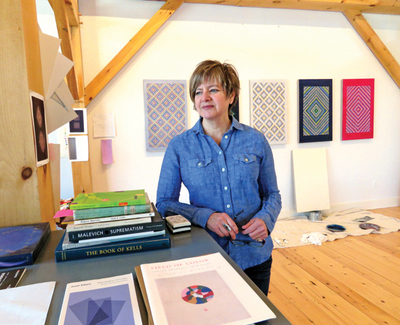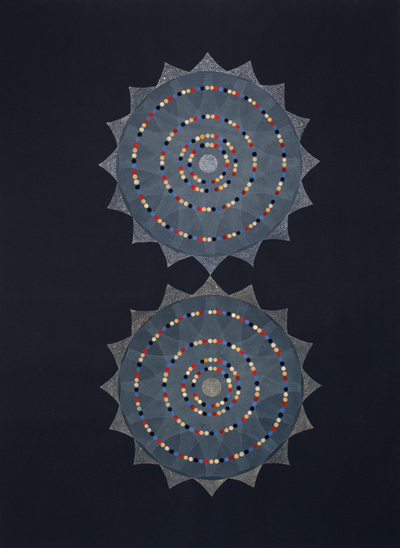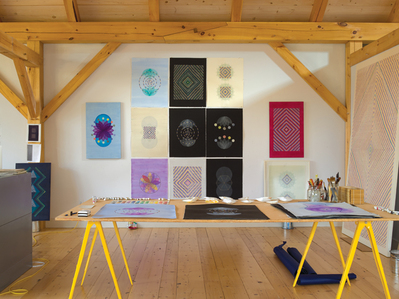Grace DeGennaro
Grace DeGennaro in her studio in Yarmouth, ME, 2015. Photo: David Wade.
Maine is predominantly known for its popular realist, figurative and landscape painters. While Grace DeGennaro may be somewhat of an anomaly, she is among a group of international artists using geometric form and structure, such as those featured on Geoform, a widely respected online project curated by Julie Karabenick.
DeGennaro’s studio is in historic Yarmouth, 15 minutes north of Portland in the hayloft of a former 19th-century barn tucked in the woods. Two-story windows fill the 1,000-square-foot space with even light, evoking a serene atmosphere.
The immense control, dedication and patience DeGennaro devotes in creating these innumerable small hand-painted circles, which she calls “beads,” leaves viewers rather stunned. The repetition of these meticulously rendered beads produces a vibrating field of pulsating wavelengths of color, light and energy that stimulates the subconscious.
Grace DeGennaro, Ballinglen 7, 2012, watercolor on Arches, 30 x 22″. Photo: Luc Demers.
As minimal abstract paintings, DeGennaro’s canvases and works on paper are the fruits of a career-long study of dreams and symbols. For most of her adult life, she has written in a journal, identifying and analyzing personal archetypes in her dreams and how they fit Jungian psychological tenets as applied to the symbols and imagery of the unconscious.
She analyzes the art and iconography of non-Western indigenous cultures: Australian aboriginal art, Byzantine mosaics, Navajo weavings and tantric drawings. Her other influences include science and math: the golden mean, the Fibonacci sequence, gnomonic growth and sacred geometry.
Around the perimeter of the studio, covering every bit of wall space, are paintings of various sizes and in various stages of completion. Works of art lie flat on two massive worktables. A book of black-and-white illustrations of antique Navajo blankets, spread open on a nearby table, suggest the origins of her imagination. However, DeGennaro ratchets up these images with her own color sensibility and her hallmark circular beads. They emanate from a center axis radiating in concentric diamond-shaped designs beyond the painting’s surface, ad infinitum. Each chromatic bead performs solo and simultaneously with others as part of a pulsating swarm that moves in concert to an unheard orchestral score—advancing, receding, undulating, vibrating.
Grace DeGennaro Studio, 2014. Photo: Luc Demers.
Though DeGennaro prefers to work in the quiet of her studio, she maintains an impressive professional schedule. She has been the recipient of several grants including one from the Ballinglen Arts Foundation in 2012 and residencies, most recently at the Catwalk Institute in New York’s Hudson River Valley. She has taught in the MFA program at the Maine College of Art and at residencies at Bowdoin and Colby Colleges.
She was included in the important exhibition To Infinity and Beyond: Mathematics in Contemporary Art, in 2008, at the Heckscher Museum of Art in Huntington, NY. The show was reviewed in the New York Times as “a comprehensive presentation of contemporary and modern art inspired by mathematics, geometry, statistics, number systems, computer codes and the like….” Currently, her work is on exhibit in two American embassies: Doha, Qatar, and Tanzania, Africa. It shows a kinship of shared visual themes and design that transcends cultural differences such as in the geometric patterning of Islamic art and the horror vacui of Tanzanian art.
In 2016, her work will be included in Pattern/System/Network at the Tang Teaching Museum in Saratoga Springs, NY, an exhibit, which will feature contemporary art that explores pattern alongside historical and cultural artifacts—the perfect complement to the universality and timelessness of this artist’s work.
Andres Azucena Verzosa is co-editor of the forthcoming Art in Maine: Contemporary Perspectives (University of Maine Press, 2015).



